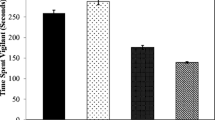Abstract
Long-term studies at Bird Island, South Georgia, show that numbers of wandering, black-browed and grey-headed albatrosses have been decreasing since the late 1970s. To determine the status of the total South Georgia population, all known colonies were censused in 2003/2004 using a combination of yacht-based digital photography and ground counts. The breeding population estimates from this census are 1,553 pairs of wandering albatross, 74,296 pairs of black-browed albatross and 47,674 pairs of grey-headed albatross. A 30% decline since 1984 was recorded for wandering albatross, and comparison of a sample of black-browed and grey-headed albatross colonies on the mainland of South Georgia photo-censused in both 1985/1986 and 2003/2004 indicates similarly substantial population declines. Unless these decreases can be halted or reversed, doubt will exist as to the long-term viability of these species of albatross at South Georgia.


Similar content being viewed by others
References
Arnold JM, Brault S, Croxall JP (2006) Albatross populations in peril? A long-term population trajectory for black-browed albatrosses at Bird Island, South Georgia. Ecol Appl (in press)
BirdLife International (2004) IUCN red list of birds. CD Rom. BirdLife International, Cambridge
Clark G (1984) Report to the British Antarctic Survey on the ‘Totorore’ expedition to South Georgia, 13 August–17 October, 1984. British Antarctic Survey archives, Cambridge
Croxall JP, Gales R (1998) An assessment of the conservation status of albatrosses. In: Robertson G, Gales R (eds) Albatross biology and conservation. Surrey Beatty, Chipping Norton, pp 46–65
Croxall JP, Nicol S (2004) Management of Southern Ocean resources: global forces and future sustainability. Antarct Sci 16:569–584
Croxall JP, Prince PA, Rothery P, Wood AG (1998) Population changes in albatrosses at South Georgia. In: Robertson G, Gales R (eds) Albatross biology and conservation. Surrey Beatty, Chipping Norton, pp 69–83
Croxall JP, Silk JRD, Phillips RA, Afanasyev V, Briggs DR (2005) Global circumnavigations: tracking year-round ranges of non-breeding albatrosses. Science 307:249–250
Cuthbert RJ, Sommer ES (2004) Population size and trends of four globally threatened seabirds at Gough Island, South Atlantic Ocean. Marine Ornithology 32:97–103
Cuthbert R, Ryan PG, Cooper J, Hilton G (2003) Demography and population trends of the Atlantic yellow-nosed albatross. Condor 105:439–452
Cuthbert R, Sommer E, Ryan P, Cooper J, Hilton G (2004) Demography and conservation of the Tristan albatross Diomedea [exulans] dabbenena. Biol Conser 117:471–481
Gales R (1998) Albatross populations: status and threats. In: Robertson G, Gales R (eds). Albatross biology and conservation. Surrey Beatty, Chipping Norton, pp 20–45
Huin N (2001) Census of the black-browed albatross population of the Falkland Islands 2000/2001. Falklands Conservation, Stanley
Lawton K, Robertson G, Valencia J, Wienecke B, Kirkwood R (2003) The status of Black-browed Albatrosses Thalassarche melanophrys at Diego de Almagro Island, Chile. Ibis 145:502–505
Moore PJ (2004) Abundance and population trends of mollymawks on Campbell Island. Science for conservation 242. New Zealand Department of Conservation, Wellington
Phillips RA, Silk JRD, Phalan B, Catry P, Croxall JP (2004) Seasonal sexual segregation in two Thalassarche albatross species: competitive exclusion, reproductive role specialization or trophic niche divergence? Pro R Soc Lond B 271:1283–1291
Phillips RA, Silk JRD, Croxall JP, Afanasyev V, Bennett VJ (2005) Summer distribution and migration of nonbreeding albatrosses: individual consistencies and implications for conservation. Ecology 86:2386–2396
Poncet S, Robertson G, Lawton K, Phillips R, Phalan B (2004) Archival data and report on the South Georgia albatross survey 2003–04. Report to the Government of South Georgia and the South Sandwich Islands. British Antarctic Survey archives, Cambridge
Prince PA, Poncet S (1987) Report to the British Antarctic Survey on the South Georgia Breeding Birds Survey 1986/87. British Antarctic Survey archives, Cambridge
Prince PA, Rothery P, Croxall JP, Wood AG (1994) Population dynamics of Black-browed and Grey-headed Albatrosses at Bird Island, South Georgia. Ibis 136:50–71
Prince PA, Croxall JP, Trathan PN, Wood AG (1998) The pelagic distribution of South Georgia albatrosses and their relationships with fisheries. In: Robertson G, Gales R (eds). Albatross biology and conservation. Surrey Beatty, Chipping Norton, pp 137–167
Robertson G, Valencia J, Arata J (2003) Summary report on the status of black-browed and grey-headed albatrosses breeding in Chile. WG-FSA-03/11, CCAMLR, Hobart, Australia
Tickell WLN (2000) Albatrosses, Pica Press, Sussex
Trathan P, Daunt F, Murphy E (1996) South Georgia: an ecological Atlas. British Antarctic Survey, Cambridge
Weimerskirch H (2004) Diseases threaten Southern Ocean albatrosses. Polar Biol 27:374–379
Acknowledgements
The support of Russ Jarvis, Denise Dudgeon, Peter Brand and Sharon Chow in securing funding for the project is gratefully acknowledged. Special thanks are due to the skipper (Dion Poncet) and crew (Ken Cripps and Edith Kraus) of SV Ada II, whose skill, experience and enthusiasm were critical to the success of the survey. We are grateful to Andy Black (Falklands Conservation), Nic Warren and Isaac Forster (British Antarctic Survey), Ken Cripps, Edith Kraus, Callan Duck and Dion Poncet (SV Ada II) for assistance with fieldwork, and to Katrina Jensz for assistance with digital image analysis. The British Antarctic Survey and in particular Peter Fretwell who drew the maps, and personnel at Bird Island and King Edward Point, the Government of South Georgia personnel Ken Passfield, Ann Prior, Pat Lurcock and Sarah Lurcock, and the owner of SV Ada II, Celia Bull, are thanked for their support. Jerome Poncet and the crew of SV Golden Fleece, and Stefan Kindberg (Elegant Cruises) and the staff and crew on MV Andrea are thanked for logistical support. This project was funded by the Government of South Georgia and the South Sandwich Islands, the United Kingdom’s Foreign and Commonwealth Office and the Sierra Club (Vancouver, Canada).
Author information
Authors and Affiliations
Corresponding author
Rights and permissions
About this article
Cite this article
Poncet, S., Robertson, G., Phillips, R.A. et al. Status and distribution of wandering, black-browed and grey-headed albatrosses breeding at South Georgia. Polar Biol 29, 772–781 (2006). https://doi.org/10.1007/s00300-006-0114-9
Received:
Revised:
Accepted:
Published:
Issue Date:
DOI: https://doi.org/10.1007/s00300-006-0114-9




